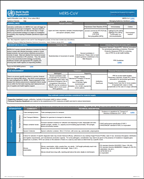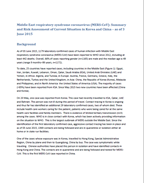

Middle East respiratory syndrome (MERS-CoV)
outbreak
Overview
Middle East respiratory syndrome coronavirus (MERS-CoV) is a virus transferred to humans from infected dromedary camels. It is a zoonotic virus, meaning it is transmitted between animals and people, and it is contractable through direct or indirect contact with infected animals. MERS-CoV has been identified in dromedaries in several countries in the Middle East, Africa and South Asia. In total, 27 countries have reported cases since 2012, leading to 858 known deaths due to the infection and related complications.
The origins of the virus are not fully understood but according to the analysis of different virus genomes it is believed that it may have originated in bats and later transmitted to camels.
Human-to-human transmission is possible, but only a few such transmissions have been found among family members living in the same household. In health care settings, however, human-to-human transmission appears to be more frequent.
WHO news
All →Publications
All →Risk evaluation of circulating Middle East respiratory syndrome coronavirus (MERS-CoV) clades and lineages
Updated: 19 November 2025This document summarizes discussions during a Technical Advisory Group on Virus Evolution (TAG-VE) meeting held on 2 June 2025,...
Research gaps and needs on Middle East respiratory syndrome coronavirus (MERS-CoV) and other emerging...
Since its identification in the Kingdom of Saudi Arabia and Jordan in 2012, Middle East respiratory syndrome coronavirus (MERS-CoV), a zoonotic virus that...

Assessment of potential risk factors of Middle East respiratory syndrome coronavirus (MERS-CoV) infection...
Note: WHO has updated the guideline; find the latest version here: How to conduct a cohort study to assess the potential risk factors of Middle East...

Surface sampling of MERS-CoV in health care settings
Note: WHO has updated the guideline; find the latest version here: How to sample surfaces in health-care settings for Middle East respiratory syndrome...
Cross-sectional seroepidemiologic study of MERS-CoV infection in high risk populations in contact with...
This study protocol outlines methods to collect data to measure the seroprevalence of cross-reactive antibodies to MERS-CoV in presumed high-risk human...

Cross-sectional seroepidemiologic study of MERS-CoV infection in high-risk populations in contact with...
Representative serologic studies are designed to collect data to estimate prevalence of antibodies to a new pathogen in a population. This information...

Case‐control study to assess potential risk factors related to human illness caused by Middle East Respiratory...
Note: WHO has updated the guideline; find the latest version here: How to conduct a case-control study to assess the potential risk factors related to...


